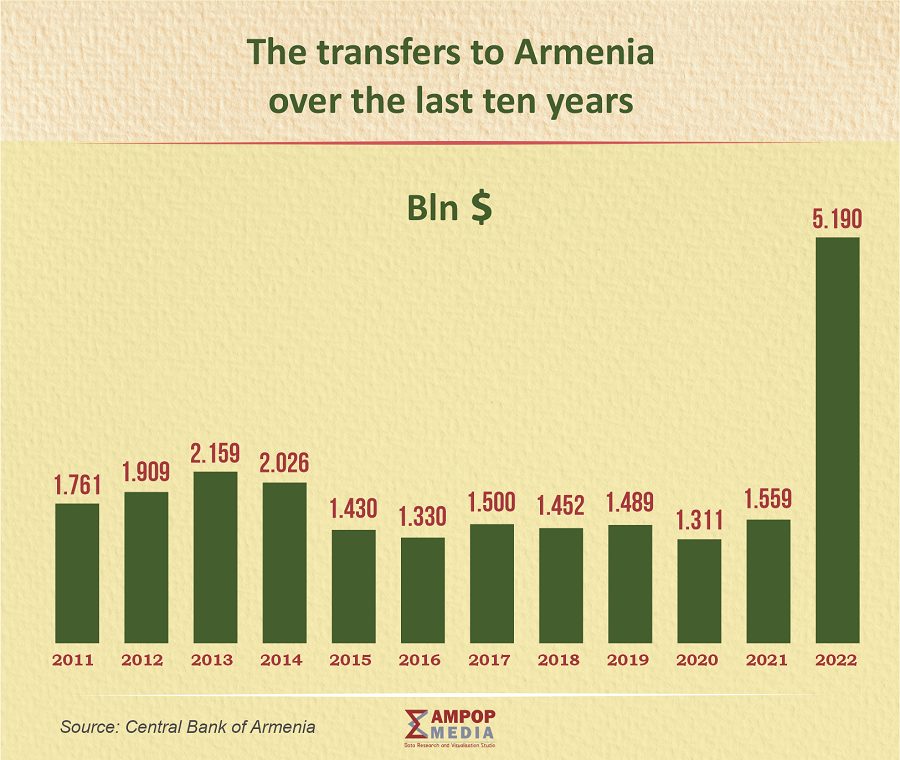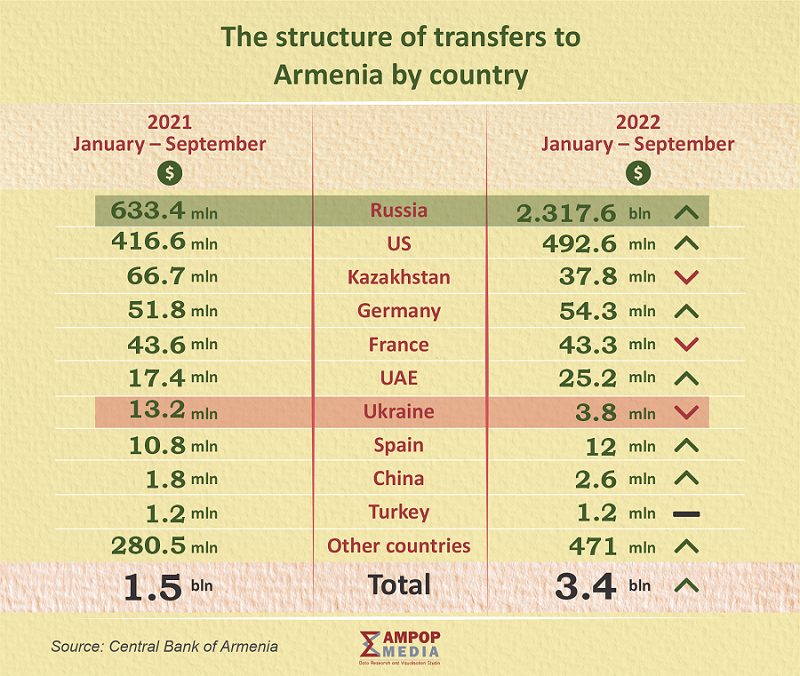About 5.2 billion USD were transferred to Armenia in the last year by individuals through banks, which is an unprecedented figure in the history of transfers to Armenia. This is a 2.5-time growth as compared to the 2.1 billion USD transferred to the country in the previous year of 2021.
A lion’s share of the transfers, which are equal to around 3.6 billion USD, was done from Russian Federation. The number has grown fourfold as compared to 2021. In 2021 only 866 million USD were transferred to Armenia from Russia. The transfers from Russia make 69% of the overall transfers to Armenia.
The growth is mostly conditioned by the inflow of foreigners in Armenia, particularly, Russians, relocating following the beginning of the Russian-Ukrainian war. In October alone Armenia has welcomed 154 847 people; the number of entries into the country for the period of January through October has made 1.4 million, half of which have been people arriving from Russia.
“The inflow of money to Armenia has grown starting from February 2022. In the previous years the annual amount of inflowing money was equal to about 2 billion USD in average; the amounts within just nine months of this year have already reached 3.5 billion USD,” Hayk Bejanyan, an economic at the “Amberd” research center says.
‘We have to be able to use the advantage properly’
Russia is followed by Ukraine, Kazakhstan, and European countries. And though Russia has always been leading the top of the countries from where the transfers to Armenia come, the statistical data has shown tendency of decrease in the recent years, explained by deterioration of Russia’s economy and fluctuations of the Russian currency exchange rates.
The situation changed in 2022 due to the conflict between Russia and Ukraine, which, economist Bejanyan believes, forces into conclusion that the inflows are conditioned by big numbers of relocating foreigners as a consequence of the conflict rather than economic reforms.
“The concerns are rather related to the short terms of the economic growth, which is mostly conditioned by foreign financial flows and increasing demand; growth is there as long as there are transfers,” Bejanyan says.
Hayk Bejanyan says the economy will keep growing as long as foreigners stay in Armenia and continue buying goods and services of local producers. Yet, the moment global problems are solved and the money inflows thin down, the growth will stop as unexpectedly as it appeared.
“As to the growth expectations for 2023, we have to take the last year’s realities as a starting point. We should refrain from overestimating the last year’s positive changes and double-digit growth; those are factors with short-term effect, which are beyond our control. The advantage we gained due to the last year’s events needs to be used properly, to exploit the possibilities it brought to ensure diversity of our economy,” the expert says.
Bejanyan says the generated funds need to be steered for the development of sectors other than the services, in order to move from growth to infrastructure development, which provides soil for sustainable perspectives in a longer run.
Dollar depreciation and unprecedented numbers of foreigners are among the many reasons behind the inflation. Inflation is tangible both in real estate market, specially, when it comes to the rates for rental, as well as in all other sectors of the country’s economy. The inflation in prices on food and non-alcoholic beverages in September 2022 has made 13.7% against the index for September of 2021; the prices of restaurant and hotel services have grown for 8.6% compared to September of the previous year; inflation is tangible also on basic food products, such as bread, vegetable oil, and others.
Economist Haykaz Fanyan from “Modex” consultancy agency says there is still no detailed study of the reasons behind the growth in transfers and those who receive them: whether those are local Armenians, or the foreigners, who have moved to Armenia. Yet, he says, the Russian-Ukrainian conflict is the most likely reason behind the growth of money inflows.
“Many Russians who have relocated to Armenia continue receiving money from Russian companies, which is why the volumes of transfers have grown. The unprecedented growth is an advantageous situation from economic perspective, but it bears some risks, too,” Fanyan says.
Growth in transfers brings about increased demands
The expert says the growth of transfers has resulted in a comprehensive increase of demand; foreigners are renting property, staying in hotels, and, thus, facilitating economic activity. However, the situation brings some risks, too, and the most fundamental one is the risk of uncertainty.
The perspectives of Russian-Ukrainian conflict are vague; so are the perspectives of its consequences. That is why, any scenario needs to be taken into account refraining from opting for short-term programs.
By Seda Ghukasyan
Infographics by Anush Baghdasaryan and Karine Darbinyan
More articles about #WarInUkraine
© All the stories, infographics and other visuals bearing the Ampop Media logo is possible to publish on other audiovisual platforms only in case of an agreement reached with Ampop Media and/or JFF.
Փորձագետի կարծիք
First Published: 17/02/2023











